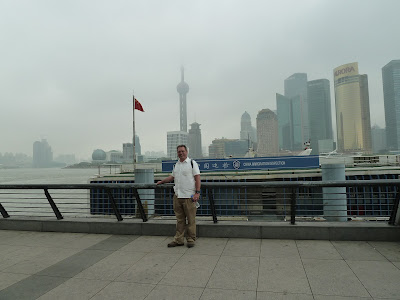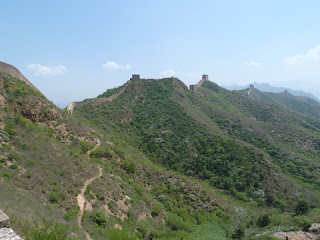 |
| This was our first glimpse of the Wall. Jinshanling section covers some of the most steep terrain. |
On our 5th day in Beijing, we joined a tour, which we booked through our hotel, to visit China's famous Great Wall. There are several sections of the wall that are restored and popular with visitors, but we'd been told that some of the areas are so tourist-ridden that it was difficult to even get a proper view of the Wall. We decided to take the road less traveled, and were glad our hotel offered round trip bus tours to Jinshanling, a more remote section. The cost for round trip bus fare, entrance fees (50 RMB), breakfast (carry out McDonalds) & lunch (buffet at a small restaurant near the trail) was included in the 240 RMB (~$40 US) and was an excellent value. (We had tried to go to the Wall 2 days earlier, thinking we could catch a bus out to the Wall on our own. Bad idea. The Wall is a 2-3 hour drive from the center of the city and the bus we found only departed after getting 30 passengers. By the time we waited for 30 minutes, we decided to go another day and book through the hotel.)

 |
| Each tower had unique features and names. Imagine the soldiers who were stationed to these lonely barracks centuries ago! It might not have seemed so quaint then, but they had this awesome view. |
 |
| I sat down on the 70 degree incline steps about half way up to catch my breath. Although I did climb to the next tower, I decided to wait with another lady (a retired viola player from Aspen, CO) while her husband, son & Ben continued to the more rugged sections (see below). |
We were glad to find vendors (who introduced themselves as Mongolian farmers) selling water and popsicles along the way. However, some also volunteered to be 'guides' and wouldn't leave us alone until we purchased a little book or souvenir and we firmly asked them to let us walk on alone. Perhaps their company would be a comfort to some, but we wanted to hike on our own. The bus driver gave us 4 hours to make our trek, and he suggested ideal routes. That amount of time was sufficient to hike, take photos, rest, and eat our lunch back at the restaurant. There is a gondola that can be ridden (50 RMB fee) from the highest point back to the base, but we didn't need to take it.
























































